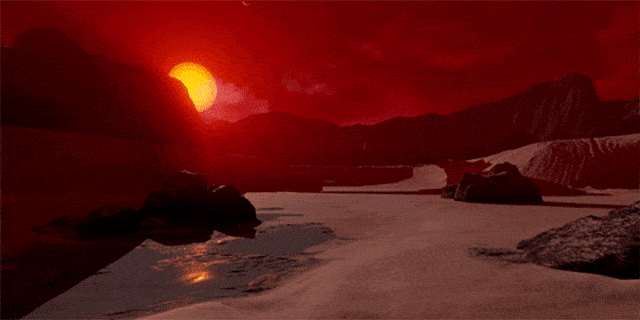
You don't need a spaceship to explore alien worlds.
An interactive, 360-degree NASA visualization tool puts you on the surface of TRAPPIST-1d, Kepler-186f and a handful of other exoplanets.
You can look all around and up, getting an eyeful of exotic landscapes and bizarre skies. And you can even do some planetary engineering, adding or removing an atmosphere and seeing how that tweak changes things. [Gallery: The Strangest Alien Planets]
As the tool points out, these are all imagined vistas: Even the closest alien planets are much too distant to photograph in any detail from Earth's neighborhood. And once you get as far out as Kepler-186f, which lies 492 light-years from the sun, even some of the most basic characteristics about a world remain elusive.
"Because Kepler-186f and the majority of Kepler-discovered planets are so distant, it is currently impossible to detect their atmospheres — if they exist at all — or characterize their atmospheric properties," said Martin Still, the program scientist for NASA's Transiting Exoplanet Survey Satellite (TESS), which launched last month.
"Consequently, we have limited knowledge about what these distant worlds are really like, but these surface visualizations allow us to imagine some of the possibilities," Still said in a statement. "Current and future NASA missions, including TESS and the James Webb Space Telescope, will find the nearest exoplanets to our solar system and characterize their atmospheres, bridging the gap between speculation and what's really out there."
TESS is following in the footsteps of NASA's Kepler space telescope, which has discovered about 70 percent of the 3,700 known exoplanets to date. But unlike Kepler, TESS will hunt for worlds around the sun's nearest neighbor stars, and some of the satellite's finds will be close enough for the $8.8 billion James Webb, which is scheduled to launch in 2020, to study in detail.
Get the Space.com Newsletter
Breaking space news, the latest updates on rocket launches, skywatching events and more!
The visualization tool is part of NASA's "Exoplanet Travel Bureau," which also offers free posters of alien worlds for download.
Follow Mike Wall on Twitter @michaeldwall and Google+. Follow us @Spacedotcom, Facebook or Google+. Originally published on Space.com.
Join our Space Forums to keep talking space on the latest missions, night sky and more! And if you have a news tip, correction or comment, let us know at: community@space.com.

Michael Wall is a Senior Space Writer with Space.com and joined the team in 2010. He primarily covers exoplanets, spaceflight and military space, but has been known to dabble in the space art beat. His book about the search for alien life, "Out There," was published on Nov. 13, 2018. Before becoming a science writer, Michael worked as a herpetologist and wildlife biologist. He has a Ph.D. in evolutionary biology from the University of Sydney, Australia, a bachelor's degree from the University of Arizona, and a graduate certificate in science writing from the University of California, Santa Cruz. To find out what his latest project is, you can follow Michael on Twitter.










